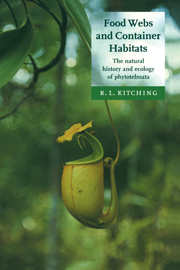Part I - The container flora, fauna and environment
Published online by Cambridge University Press: 26 August 2009
Summary
It is November in southern Ontario. An icy wind pierces clothing and trees and makes field work a chore to be hastened rather than the usual pleasure. We walk down to a boggy lakeside, ice crackling underfoot – making crossing a makeshift bridge more than usually difficult. On the lake itself the ice is spreading: not yet locking down the whole surface but forming a corona around the rim on which the black ducks stand disconsolately. The ground vegetation changes as we approach the lake: from leaf litter and the dried grass tussocks of winter, it becomes spongy sphagnum bog interspersed with a few dwarf pines. And it is deeply embedded in this sphagnum that Dolf Harmsen of Queen's University and I find what we are looking for. Just visible above the moss profile are the red and green leaves of Sarracenia pitcher plants: still half-filled with liquid and, even in the winter cold, with one or two larvae of the pitcher-plant mosquito, Wyeomyia smithii, swimming within them. The rest of the bog is biologically silent, only the wind in the pines breaking the heavy winter pall which hangs over the northland – at least to the eye and ear of an antipodean naturalist!
In contrast, I think of a village stand of bamboos just outside Madang in New Guinea. The air is hot and humid and filled with mosquitoes. The grove of bamboos is enormous and the stems themselves up to ten or even twenty centimetres across.
- Type
- Chapter
- Information
- Food Webs and Container HabitatsThe Natural History and Ecology of Phytotelmata, pp. 15 - 16Publisher: Cambridge University PressPrint publication year: 2000
- 1
- Cited by



